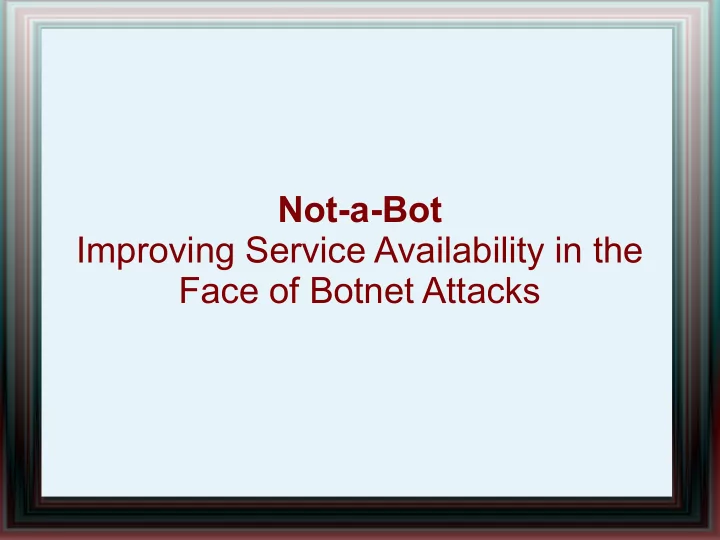

Not-a-Bot Improving Service Availability in the Face of Botnet Attacks
Overview ● Introduction to the problem ● Architecture of NAB ● A way to attest human-generated traffic ● Use of attestation to mitigate presented problems ● Results
Introduction to the problem ● Significant part of internet traffic is bot-generated ● Top 6 bot-nets generate: – 85% of spam, which is 120 billion of messages in 95% inboxes – 5% of web-traffic is generated through DDoS (Distributed Denial of Service). 4000 different attacks per week on average – 14-20% of all ad clicks
Introduction to the problem ● Problems of spam, DDoS and Click Fraud would be significantly mitigated if it would be possible to distinguish bot and human-generated traffic. ● Unfortunately, no good solution is known today.
Introduction to the problem ● Traditional human activity solutions such as CAPTCHAs are not suitable in most cases : – CAPTCHAs are used today for coarse-grained actions such as email account creation, they are considered too intrusive to be used for finer granularity requests such as sending email or retrieving web URLs. – CAPTCHAs do not link to the actual request, so unaware users might by redirected to solve them. – CAPTCHAs are solvable by computer algorithms.
Introduction to the problem ● Automated way of generating attestations of human-based origin of web traffic is needed. ● Unfortunately software or operating system of infected machine cannot be trusted.
NAB = Attester + Verifier ● NAB consists of Attester working on a Client and a Verifier working on a server. ● Attester automatically generates attestations of human-based origin of actions based on monitoring of input devices (keyboard and mouse). ● Verifier verifies correctness of attestations.
NAB - Architecture ● Built prototype of NAB works with: – Virtual machine monitor XEN, which provides separation of infected operating system from NAB code. (30,000 LOC + 500 LOC of attester) – Trusted Platform Module (TPM) Chip, which provides secure access to input devices (keyboard and mouse). ● Above components together with input devices form Trusted Computing Base (TCB)
NAB - Architecture
NAB - Architecture ● Presented approach could be implemented without virtualization: – Attester built into hardware – Use of platforms providing execution of trusted code (Intel TXT, AMD Pacifica, Flicker)
NAB – Goal ● Distinguish human-generated traffic from bot-generated traffic, without the need for additional user action. ● Reduce bot-generated traffic to at most 10% of current value, recognizing all the traffic generated by human as valid.
Trusted Module Platform ● TMP is a small chip specified by Trusted Computing Group to strengthen the security of computer systems. ● Used by NAB : – For safe loading of Attester – To anonymously sign messages (service Direct Anonymous attestation) – Contains Attestation Identity Key as a basis for the key used to sing messages. – Other
Trusted Module Platform
Attester ● Generates attestations at the request of the client application (browser, email client) ● May refuse to generate an attestation if it considers that there had been no human-based activity causing a particular action.
Attester ● Certificates issued by Attester are: – Not transferable. Certificates issued by one Attester are not valid certificates of another. – Associated with the certified action. Contain a hash of the certified message.
Attester ● Attester issue a certificate if mouse or keyboard have been used in less than ∆K i ∆M respectively. ● Values of ∆K i ∆M are determined separately for each application – ∆K = ∆M = 1s for the browser – ∆K = ∆M > 1s for email client
Attester ● A more sophisticated method of issuing certificates based on characters generated with the keyboard was also considered. This method was abandoned due to the excessive complication related to multi-task nature of work on a modern computer.
Attester ● Attester in the created prototype needs less than 10 ^ 7 cycles of the CPU, which is less than 10 ms on a 2GHz processor. It is less than the time needed to establish a TCP / IP connection, and therefore it's easily acceptable.
Verifier ● The verifier module operates on the server, validating the certificates issued by the Attester. ● The verifier processes attestations at a rate of more than 10,000 attestations per second on a 2 GHz Core 2 processor.
Verifier and Spam ● Verifier is located on the ISP's email server. ● With the attestations issued by the attester, you can set up a classic anti-spam filters more aggressively, adding points to the messages with correct attestations. ● This policy encourages customers to use NAB as their e-mails are rewarded in the spam filter.
Verifier and DDoS ● Server equipped with Verifier prioritizes requests with valid attestations over those that lack them. ● In the case of DDoS attacks, users provided with attester will not feel the effects of the attack.
Verifier and Click Fraud ● Companies displaying ads (Google, Yahoo, etc.) can use Verifier to ensure their customers about the human origins of the clicks.
Results ● The system have been tested with 328 volunteers using it for a month. ● Tests of the system on infected computers (honeypots) have also been performed.
Results ● The amount of spam which got to the inboxes have been reduced by 92%, while not classifying any human-generated message as spam. ● In the simulation of a DDoS attack 89% of requests generated by bots have been detected and it's priority has been decreased. A significant impact on the human-generated requests has not been noticed. ● 87% of bot-generated clicks have been detected, without losing any of the human-generated clicks.
Q&A
Recommend
More recommend